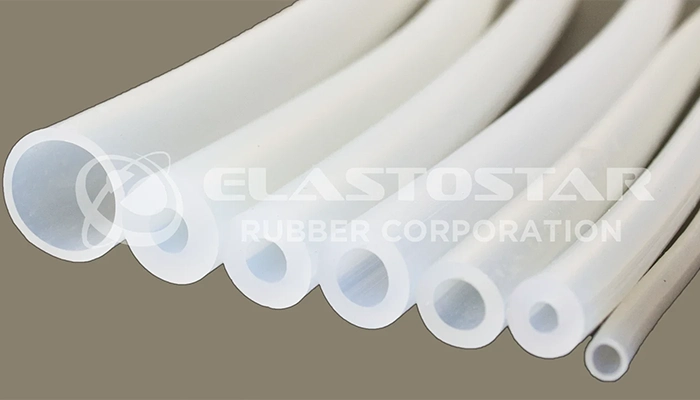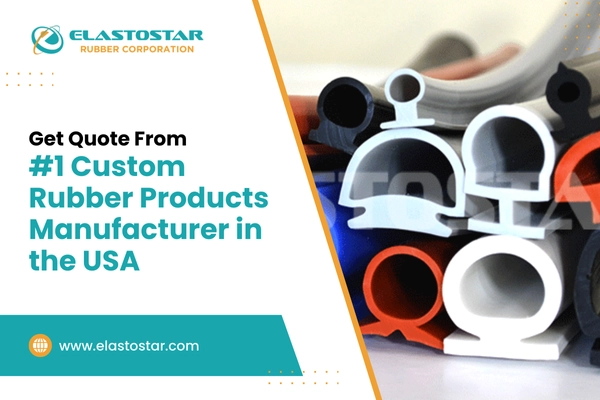Silicone rubber tubing is versatile in various industries, from healthcare to automotive and even food processing. Its flexibility, durability, and resistance to extreme temperatures make it an ideal choice for many applications, including food-safe tubing in the food and beverage industry. Its use in creating FDA-approved rubber products ensures it meets strict safety standards, making it reliable for sensitive applications like medical devices and FDA-approved seals for food processing equipment.
In this blog, we’ll examine the process of making silicone rubber tubing and explore why it’s a popular choice across industries. Keep reading to learn more!
Table of Contents
What Is Silicone Rubber Tubing?

Silicone rubber tubing is widely used across various industries for its flexibility, durability, and resistance to extreme temperatures. Made from FDA-approved silicone rubber, it is ideal for demanding medical, automotive, and food-processing applications.
In the food industry, food-safe tubing ensures that materials in contact with food meet strict safety standards, including FDA-approved seals. It’s also used in medical applications for devices that require sterility and biocompatibility.
For industries that require contamination control, such as food and pharmaceuticals, detectable gaskets and metal detectable rubber seals are used to identify and eliminate any potential foreign material risks quickly.This makes silicone rubber tubing a unique material, not just for its performance in challenging environments but also for ensuring the highest levels of safety and compliance across industries.
The Silicone Rubber Tubing Manufacturing Process
The manufacturing of silicone rubber tubing involves several key steps to ensure it meets the specific needs of various industries.
1. Raw Silicone Rubber Preparation
The process begins with preparing raw silicone rubber, mixed with necessary additives to achieve the desired properties, such as flexibility, durability, and heat resistance. For applications like food-safe tubing, the material must comply with stringent safety regulations, using FDA-approved rubber materials to ensure it is safe for contact with food.
2. The Extrusion Process
In the extrusion process, the prepared silicone rubber is shaped into tubing by being pushed through an extruder, where it is formed into specific dimensions. This step allows for customization of the tubing’s diameter and wall thickness, for various uses such as medical-grade, automotive, and food-safe tubing.
3. Curing (Vulcanization)
Once the tubing is formed, it undergoes curing or vulcanization, where it is heated to strengthen the material and enhance its durability. This process is essential to ensure the tubing can handle high temperatures and remain flexible under harsh conditions. The curing process must meet health and safety standards for food-safe tubing and FDA-approved seals.
4. Variations for Specific Applications
Different industries have unique requirements, and the manufacturing process is adjusted accordingly.
- Medical-grade silicone tubing must be sterile and biocompatible, often requiring additional testing.
- Automotive silicone tubing is reinforced for high-pressure and high-temperature environments.
- Food-safe tubing is made with FDA-approved rubber materials, ensuring it is non-toxic and suitable for food handling.
- Metal detectable rubber and metal detectable seals are used in food processing and pharmaceuticals to help detect contamination quickly, ensuring safety in sensitive environments.
5. Quality Control Checks
To guarantee performance and safety, all silicone tubing undergoes rigorous quality control checks. For example, FDA-approved seals and food-safe tubing must comply with strict health regulations.
At the same time, detectable gaskets and metal detectable rubber products undergo specific tests to ensure they can be identified by metal detectors, preventing potential contamination in food and pharmaceutical products.
What are the 4 Applications of Silicone Rubber Tubing?
Silicone rubber tubing is known for its flexibility, durability, and resistance to high temperatures, making it incredibly versatile. These qualities make it a go-to choice in the healthcare, automotive, and food processing industries.
1. Medical-Grade Silicone Tubing
In the medical industry, silicone tubing is often used in devices like catheters and pumps because it is biocompatible and can handle sterilization without breaking down. It’s perfect for situations where the tubing needs to be in contact with the body or medical fluids. Since FDA-approved rubber materials are required in healthcare, this type of tubing meets strict safety and hygiene standards.
- Safe for the human body and medical environments.
- It can be sterilized repeatedly.
- Complies with regulatory requirements, like FDA and USP Class VI standards.
2. Automotive Silicone Tubing
In the automotive world, silicone rubber pipes and tubing are often used in places exposed to high heat and chemicals, such as in radiator hoses, vacuum lines, and turbo systems. Silicone is resistant to oils and coolants, so it doesn’t wear down as quickly as other materials, making it a reliable choice for long-term use.
- Holds high temperatures and pressure.
- Resistant to automotive fluids like oil and coolant.
- Maintains performance over time, even in harsh conditions.
3. Food-Grade Silicone Tubing
Safety is critical in food processing. Food-safe tubing made from FDA-approved silicone rubber ensures that the material in contact with food is non-toxic, odorless, and can handle hot and cold temperatures. This type of tubing is used in food and beverage production, in systems like dispensers, food processing equipment, and even brewing operations.
- Non-toxic and odorless, making it safe for food contact.
- Performs well in both high and low-temperature environments.
- Meets FDA standards to ensure food safety.
4. Metal Detectable Seals and Gaskets
In industries like food processing and pharmaceuticals, where contamination must be avoided, metal-detectable seals must be avoided at all costs. These seals are made from metal-detectable rubber, ensuring that any small fragments can be easily found and removed during processing, which helps keep the product safe and free of contamination.
Read More– How Silicone Rubber Tubing Is Made For Different Application?
Why Is Silicone Rubber Tubing Chosen Over Other Materials?
When compared to other materials like PVC, latex, or rubber, silicone rubber tubing stands out for several reasons. For one, silicone can handle higher temperatures than most other materials, so it’s often used in industries where heat resistance is important, like automotive and food processing.
- Temperature Resistance: Silicone can tolerate a much wider range of temperatures than PVC or latex, making it ideal for hot and cold environments.
- Chemical Resistance: Unlike many materials, silicone doesn’t easily react with oils, chemicals, or UV light, which means it lasts longer in environments where those elements are present.
- Durability: Even in extreme conditions, silicone remains flexible and doesn’t crack or degrade as other materials might, making it a more reliable option for long-term use.
Factors to Consider When Choosing Silicone Rubber Tubing
When selecting silicone rubber tubing, it’s important to consider specific factors based on your application’s needs.
| Factor | What to Consider |
| Temperature Resistance | Choose tubing that can handle the temperatures in your application (high or low). |
| Compliance | Check if the tubing is resistant to any chemicals it will contact. |
| Pressure Requirements | If the tubing will handle high pressure (like in fuel or hydraulic systems), go for reinforced options |
| Chemical Exposure | Check if the tubing is resistant to any chemicals it will come in contact with. |
By considering these factors, you’ll be able to choose the right silicone rubber tubing for your specific needs, ensuring both performance and safety.
Why Is Silicone Rubber Tubing Chosen Over Other Materials?
When compared to other materials like PVC, latex, or rubber, silicone rubber tubing stands out for several reasons. For one, silicone can handle higher temperatures than most other materials, so it’s often used in industries where heat resistance is important, like automotive and food processing.
- Temperature Resistance: Silicone can tolerate a much wider range of temperatures than PVC or latex, making it ideal for hot and cold environments.
- Chemical Resistance: Unlike many materials, silicone doesn’t easily react with oils, chemicals, or UV light, which means it lasts longer in environments where those elements are present.
- Durability: Even in extreme conditions, silicone remains flexible and doesn’t crack or degrade as other materials might, making it a more reliable option for long-term use.
Read More – Top Industry Where Silicone Rubber Tubing Is Highly Required
Factors to Consider When Choosing Silicone Rubber Tubing
When selecting silicone rubber tubing, it’s important to consider specific factors based on your application’s needs.
| Factor | What to Consider |
| Temperature Resistance | Choose tubing that can handle the temperatures in your application (high or low). |
| Compliance | Ensure the tubing meets FDA or USP Class VI standards for food or medical use. |
| Pressure Requirements | If the tubing will handle high pressure (like in fuel or hydraulic systems), go for reinforced options |
| Chemical Exposure | Ensure the tubing meets FDA or USP Class VI standards for food or medical use. |
By considering these factors, you can choose the right silicone rubber tubing for your specific needs, ensuring both performance and safety.
Why Elastostar Rubber Corporation?
- Expertise: Decades of experience providing silicone tubing to manufacturers, dealers, and various industries.
- Certified Quality: We use FDA-approved rubber that meets USP Class VI standards for safety and compliance.
- Custom Solutions: Our tubing is customized to your specific needs, ensuring reliable performance in any application.
For more use and application, please contact us with your details, email us at info@elastostar.com, or Call us at 614-841-4400. We will help you explore more ways to utilize our products for your special purpose.
Recommended Reads
- Silicone Rubber: Where It Comes From
- Silicone Rubber Frequently Asked Questions
- Silicone Rubber Temperature: How Much Heat Can It Withstand?

Conclusion
Silicone rubber tubing is widely used in the medical, automotive, and food processing industries for its flexibility, durability, and resistance to extreme temperatures. It is FDA-approved rubber and USP Class VI compliant, ensuring safety and reliability in sensitive applications. Custom options, including reinforced tubing for high-pressure environments and metal detectable seals for contamination prevention for various industrial needs.
FAQs
What are the different types of silicone tubing?
There are various types of silicone tubing, including medical-grade, food-safe, automotive, and reinforced silicone tubing. Elastostar Rubber Corporation offers customized solutions for each type, ensuring they meet industry-specific requirements for flexibility, heat resistance, and FDA-approved standards.
What are the applications of silicone tubing?
Silicone tubing is commonly used in medical devices, automotive systems, and food processing equipment. Its flexibility, temperature resistance, and use of FDA-approved silicone rubber make it suitable for a wide range of industries that require durability and safety.
How is a silicone tube made?
A silicone tube is made through the extrusion process, where FDA-approved silicone rubber is shaped into tubing and then cured or vulcanized to enhance its strength and flexibility. It can be customized for specific uses such as medical-grade tubing
How is rubber tubing made?
Rubber tubing, including silicone rubber tubing, is created by extruding raw rubber into the desired shape and then curing it through vulcanization. Elastostar Rubber Corporation offers high-quality, durable rubber tubing for automotive systems, medical devices, and food-safe tubing applications.


